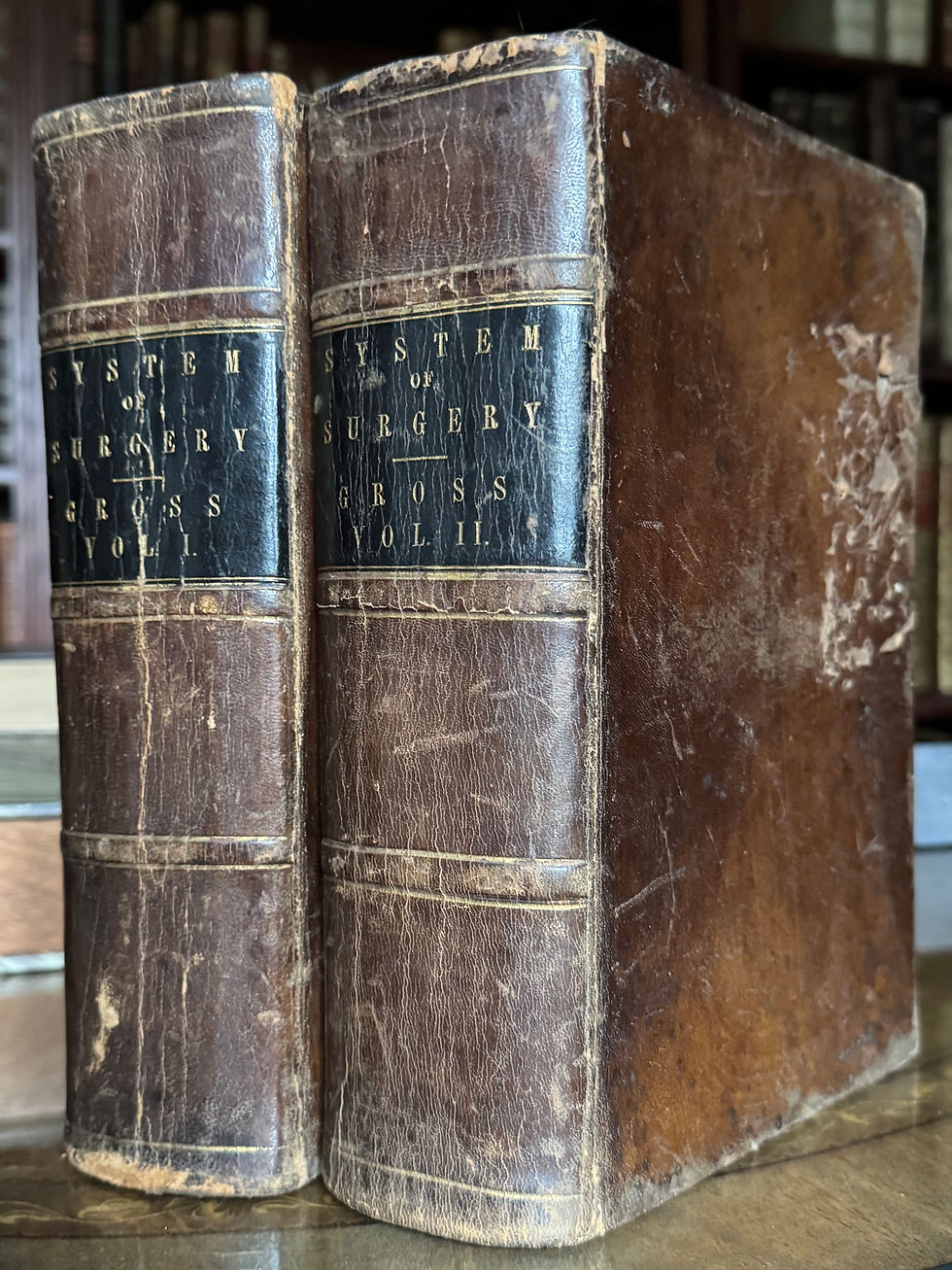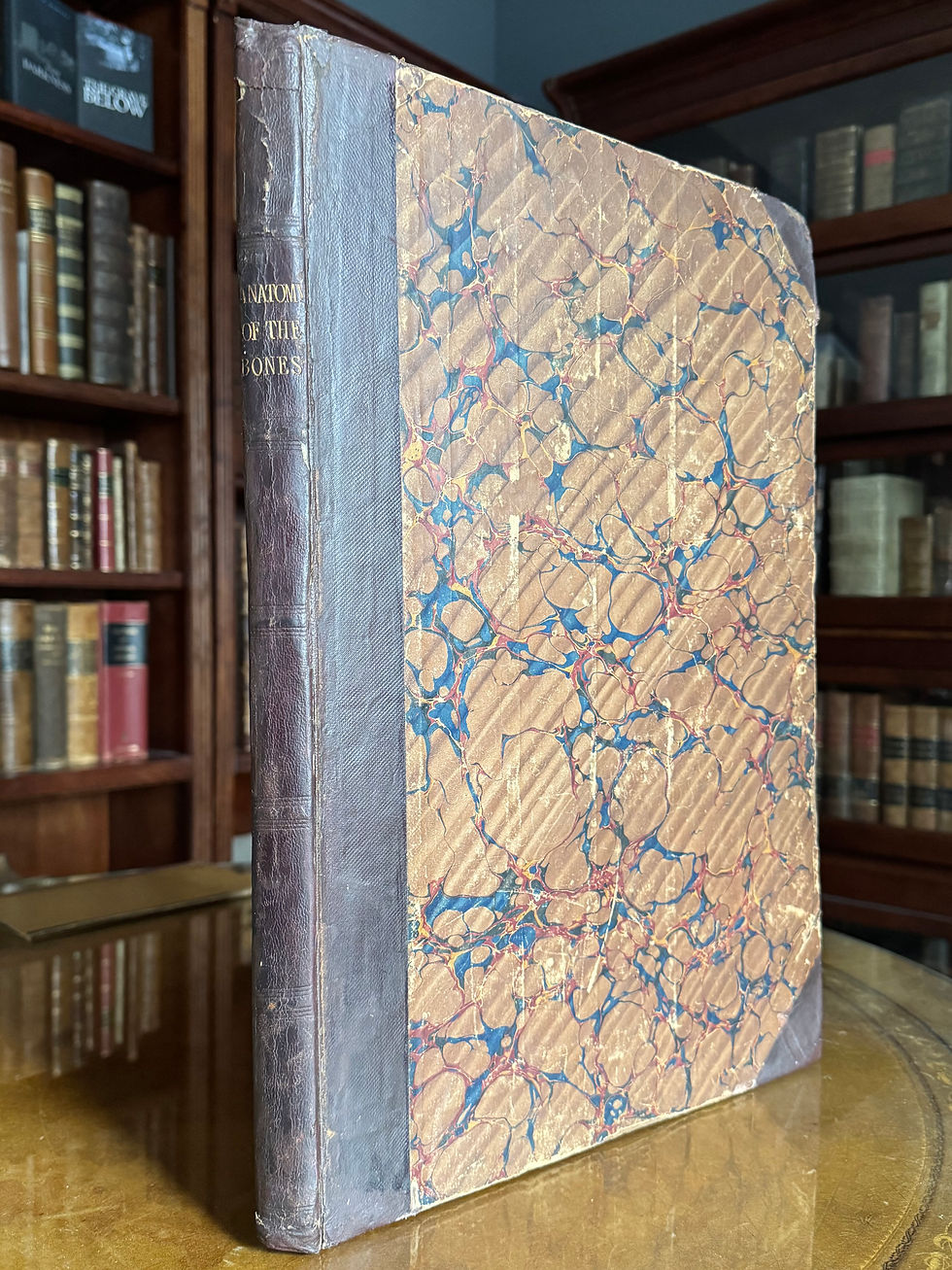Cowper, Anatomia Corporum Humanorum, 1739. (Howard Atwood Kelly’s Copy)
Anatomia Corporum Humanorum Cetrum et Qatuordecim Tabulis, Singulari Artificio, Nec Minori Elegantia Ab Excellentissimis, Qui In Europa Sunt, Artificibus Ad Vivum Expressis, atque In Aes Incisis Illustrata, Amplius Explicata, Multisque Novis Anatomicis Inventis, Chriurgicsque Observationeibus Aucta A Guilielmo Cowper Accedunt Ejusdem Introductio In Oeconomiam Animalium. & Index in totum Opus. Omnia Nunc Primum Latinitate Donata. Curante Guilielmo Dundass, Brittanno M. D. Lugduni Batavorum, Joannem Arnoldum Langerak, 1739.
Respined in red cloth with leather title label. Faux black reptile skin boards, with red corners. Boards scuffed. Large book plate (Howard A Kelley) on front paste down. Howard A Kelly also neatly written in cursive at top of front pastedown. Engraved title toned, a bit soiled, and damp stained. “Geo. Bruce” written in an early hand on title page. Paper repair along bottom of Tab 10, with slight loss of bottom edge of image (mostly just blank margin though). Damp stain along fore-edge of Aa, and top corner of several later leaves.
Housed in a new box with marbled boards and dark red leather spine detailed in gold. Wood sides with magnetic closure.
Small loosely inserted chromolithograph illustrating basicranial fractures, of uncertain date and origin.
Ffep, engraved title, title, *, A-C^2, A1, I, II, A2, III, IV, C1, V, VI, D1, VII, VIII, E1, IX, X, F1, XI, XII, G1, XIII, XIV, H1, XV, XVI, I1, XVII, XVIII, K1, XIX, XX, L1, XXI, XXII, M1, XXIII (bifolium), XXIV, N1, XXV, XXVI, O1, XXVII, XXVIII (unnumbered), P1, XXIX, XXX, Q1, XXXI, XXXII, R1, XXXIII, XXXIV, S1, XXXV, XXXVI, T1, XXXVII, XXXVIII, U1, XXXIX, XL, XI, XLI, XLII, Y1, XLIII, XLIV, Z1, XLV, XLVI, Aa, XLVII, XLVIII, Bb, XLIX, L, Cc, LI, LII, Dd, LIII, LIV, Ee, LV, LVI, Ff, LVII, LVIII, Gg, LIX, LX, Hh, LXI, LXII, Ii, LXIII, LXIV, Kk, LXV, LXVI, Ll, LXVII, LXVIII, Mm, LXIX, App Tab. 1. (slightly trimmed), LXX, App Tab. 2. (slightly trimmed), Nn, LXXI, LXXII, Oo, LXXIII, LXXIV, Pp, LXXV, LXXVI, Qq, LXXVII, LXXVIII, Rr, LXXIX, LXXX, Ss, LXXXI, LXXXII, Tt, LXXXIII, LXXXIV, Uu, LXXXV, LXXXVI, Xx, Yy, LXXXIX, XC, Zz, XCI, XCII, Aaa, XCIII, XCIV, Bbb, XCV, XCVI, Ccc, XCVII, XCVIII, Ddd, XCIX, C, Eee, CI, CII, Fff, CIII, CIV, Ggg, CV, Hhh, Iii, App Tab. 3. (bifolium), Kkk, App Tab. 4., App Tab. 5., Lll, App Tab. 6., App Tab. 7., Mmm, App Tab. 8., App Tab. 9., Nnn^2, rfep.
LXXX & LXXXI– slightly trimmed at top. Table 23 – slightly trimmed into image. Tables 1 and 2 seem to be signature B as catchwords are complete
“William Cowper (1666-1709) had been born at Paterfield, Sussex, and at sixteen was apprenticed to William Bignall, a London Surgeon. In 1691 Cowper settled in London. He became a Fellow of the Royal Society in 1696, and died in 1709 at Bishop Sutton, Hampshire, to which place he had retired.”
Govert (Govard; Godfried) Bidloo (1649 – 1713) was professor of anatomy at The Hague, and later in Leyden, then was physician to William (of Orange) III of England. In 1685 he published an anatomy atlas titled Godefridi Bidloo, medicinae doctoris et chirurgi, Anatomia humani corporis.... The engravings were drawn by Gerard de Lairesse, and (per Haller, Boerhaave, and also Moehsen), engraved Peter and Peter and Philip Van Gunst. Despite the elegant and “artistically perfect” engravings, the work was poorly received. The explanation of the plates was too short for any but beginner anatomists (and it was too expensive for the beginner), also the plates were not comprehensive enough for artists. “On account of the probably small sale of the work the publishers gave three hundred impressions of these plates to the English surgeon and anatomist, William Cowper (1666 – 1709). He later published these plates with a new text in English over his own name. … [Following the 105 Lairesse plates there are] 9 plates of the same size, newly added by Cowper, which are drawn by Henry Cook and engraved by Michiel van der Gucht. … Bidloo resented this crude piece of plagiarism most bitterly and an exchange of polemic writings between him and Cowper followed.” Johann Arnold Langerak published a later Latin edition with impression taken from the old plates in 1739, titled as Anatomia Corporum humanorum 114 tabulis.... (it actually contains 115 plates). (Choulant, 1852).
A 1737 English edition was edited by Albinus. Cowper’s text was superior to that of Bidloo’s, as he added in ink additional letters and further explanation to the plates. Cowper’s publication was much more well received (as testified by the subsequent editions).
Heirs of Hippocrates states, “Before the days of copyright, this is one of the most famous instances of plagiarism in the history of medicine. … Thes plates are considered among the finest illustrations of the Baroque period....”
“The plates...include ropes, books, blocks, pins supporting body parts, and even a fly creeping across a dissection of the abdomen. They were intended to be lifelike imitations of what became visible during a dissection. … The anatomical atlas infuriated [Frederik] Ruysch, who accused Bidloo of inaccuracies.... the conflict with his former anatomy teacher ended in bitter accusations involving each other’s morals and character.... William III of England... ‘died in Bidloo’s arms’ in 1702. In his often polemic literary writings Bidloo stepped on many toes, and William III regularly intervened to keep him out trouble—and even out of prison.” (Bynum & Bynum, vol 1, pg 211).
Heirs 468 gives [138] pp. 114 plates (part fold.). 52.1 cm.
See G-M 385 and 385.1, which indicate that Bidloo’s atlas (and thus, subsequently Cowper’s) was the largest and most beautiful of the 17th century anatomic atlases.
Howard Atwood Kelly:
Howard Atwood Kelly (1858 – 1943) was one of the Big Four (along with Osler, Welch, and Halsted) who founded Johns Hopkins. “The emergence of modern gynecology in America is due in large part to the work of Howard Kelly, professor of gynecology at the University of Pennsylvania and later at Johns Hopkins. Kelly made pioneering conributions in such areas as the use of cocaine as a local anesthetic in the treatment of uternine displacement, ureter catheterization, the diagnosis of ureteral calculi, the treatment of vesicovaginal fistula and a host of other diagnostic and therapeutic advances. … Kelly was equally renosned as a medical historian and biographer, his Cyclopedia of American medical biography (1912) being especially noteworthy.” (Heirs 1139)
“Kelly was one of the first influential male physicians in America to advocate for the advancement of women physicians.” (G-M 13592)
Bookplate reads: “ίνα μερίζω τοις έμε αγαπωσιν ύπαρξιν και τους θησαυρούς αυτών εμπλησω αγαθών εξ βιβλιοθήκη.” (In order to fill up my treasure store, I share those good things which happen to be in my beloved library.)
















